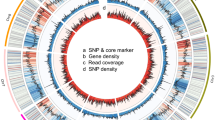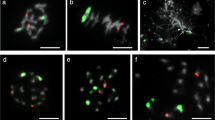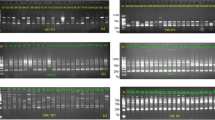Abstract
The AFLP technique is a powerful DNA fingerprinting technology applicable to any organism without the need for prior sequence knowledge. The protocol involves the selective PCR amplification of restriction fragments of a total digest of genomic DNA, typically obtained with a mix of two restriction enzymes. Two limited sets of AFLP primers are sufficient to generate a large number of different primer combinations (PCs), each of which will yield unique fingerprints. Visualization of AFLP fingerprints after gel electrophoresis of AFLP products is described using either a conventional autoradiography platform or an automated LI-COR system. The AFLP technology has been used predominantly for assessing the degree of variability among plant cultivars, establishing linkage groups in crosses and saturating genomic regions with markers for gene landing efforts. AFLP fragments may also be used as physical markers to determine the overlap and positions of genomic clones and to integrate genetic and physical maps. Crucial characteristics of the AFLP technology are its robustness, reliability and quantitative nature. This latter feature has been exploited for co-dominant scoring of AFLP markers in sample collections such as F2 or back-cross populations using appropriate AFLP scoring software. This protocol can be completed in 2–3 d.
This is a preview of subscription content, access via your institution
Access options
Subscribe to this journal
Receive 12 print issues and online access
$259.00 per year
only $21.58 per issue
Buy this article
- Purchase on Springer Link
- Instant access to full article PDF
Prices may be subject to local taxes which are calculated during checkout




Similar content being viewed by others
Change history
14 August 2008
In the version of this article initially published, the three genotype classes in Figure 3b were incorrectly described in the legend. "A: homozygous as the first parent; H: heterozygous, B: homozygous as the second parent" should have read "A: homozygous absent; H: heterozygous; B:homozygous present". This error has been corrected in the HTML and PDF versions of the article.
References
Vos, P. et al. AFLP: a new technique for DNA fingerprinting. Nucleic Acids Res. 23, 4407–4414 (1995).
Heun, M. et al. Site of einkorn wheat domestication identified by DNA fingerprinting. Science 278, 1312–1314 (1997).
Janssen, P. et al. Evaluation of the DNA fingerprinting method AFLP as an new tool in bacterial taxonomy. Microbiology 142, 1881–1893 (1996).
Roldan-Ruiz, I. et al. Estimating genetic conformity between related ryegrass (Lolium) varieties. 2. AFLP characterization. Mol. Breed. 6, 539–602 (2000).
Vosman, B., Visser, D., van der Voort, J.R., Smulders, M.J. & van Eeuwijk, F. The establishment of 'essential derivation' among rose varieties, using AFLP. Theor. Appl. Genet. 109, 1718–1725 (2004).
Hansen, M., Kraft, T., Ganestam, S., Sall, T. & Nilsson, N.O. Linkage disequilibrium mapping of the bolting gene in sea beet using AFLP markers. Genet. Res. 77, 61–66 (2001).
Stich, B. et al. Comparison of linkage disequilibrium in elite European maize inbred lines using AFLP and SSR markers. Mol. Breed. 17, 217–226 (2006).
Tsuji, S. et al. An association study using AFLP markers and application to a beef cattle breeding population. Anim. Genet. 35, 40–43 (2004).
Vuylsteke, M., Kuiper, M. & Stam, P. Chromosomal regions involved in hybrid performance and heterosis: their AFLP-based identification and practical use in prediction models. Heredity 85, 208–218 (2000).
Vuylsteke, M. Genetic Analysis of Maize by Using the AFLP Method. Ph.D. thesis. Wageningen University, Wageningen, The Netherlands., ISBN 90-5808-044-7 (1999).
Vuylsteke, M., Mank, R., Brugmans, B., Stam, P. & Kuiper, M. Further characterization of AFLP data as a tool in genetic diversity assessments among maize (Zea mays L.) inbred lines. Mol. Breed. 6, 265–276 (2000).
Peters, S.A. et al. TOPAAS, a tomato and potato assembly assistance system for selection and finishing of bacterial artificial chromosomes. Plant Physiol. 140, 805–817 (2006).
Peters, J.L. et al. A physical amplified fragment-length polymorphism map of Arabidopsis. Plant Physiol. 127, 1579–1589 (2001).
Srinivasan, J. et al. An integrated physical and genetic map of the nematode Pristionchus pacificus . Mol. Genet. Genomics 269, 715–722 (2003).
Gorni, C. et al. Application of AFLP technology to radiation hybrid mapping. Chromosome Res. 12, 285–297 (2004).
Van Eijk, M.J., de Ruiter, M., Broekhof, J. & Peleman, J. Discovery and detection of polymorphic microsatellites by microsatellite-AFLP. Abstract presented at the Plant and Animal Genome IX Conference, January 13–17, 2001 (San Diego, CA), #P331, 143 (http://www.intl-pag.org/pag/9/abstracts/P3d_16.html).
Van den Broeck, D. et al. Transposon display identifies individual transposable elements in high copy number lines. Plant J. 13, 121–129 (1998).
Piepho, H.P. & Koch, G. Codominant analysis of banding data from a dominant marker system by normal mixtures. Genetics 155, 1459–1468 (2000).
Jansen, R.C., Geerlings, H., Van Oeveren, A.J. & Van Schaik, R.C. A comment on codominant scoring of AFLP markers. Genetics 158, 925–926 (2001).
Vuylsteke, M. et al. Two high-density AFLP (linkage maps of Zea mays L.: analysis of distribution of AFLP markers. Theor. Appl. Genet. 99, 921–935 (1999).
Menz, M.A. et al. Genetic diversity of public inbreds of sorghum determined by mapped AFLP and SSR markers. Crop Sci. 44, 1236–1244 (2004).
Herbergs, J., Siwek, M., Crooijmans, R.P., Van der Poel, J.J. & Groenen, M.A. Multicolour fluorescent detection and mapping of AFLP markers in chicken (Gallus domesticus). Anim. Genet. 30, 274–285 (1999).
Ajmone-Marsan, P. et al. AFLP markers for DNA fingerprinting in cattle. Anim. Genet. 28, 418–426 (1997).
Cameron, N.D., van Eijk, M.J., Brugmans, B. & Peleman, J. Discrimination between selected lines of pigs using AFLP markers. Heredity 91, 494–501 (2003).
Knorr, C., Cheng, H.H. & Dodgson, J.B. Application of AFLP markers to genome mapping in poultry. Anim. Genet. 30, 28–35 (1999).
Paxton, C.N., Pierpont, M.E. & Kooyman, D.L. Identification of AFLP markers associated with round heart syndrome in turkeys. Int. J. Poultry Sci. 4, 133–137 (2005).
de Gruijter, J.M., Gasser, R.B., Polderman, A.M., Asigri, V. & Dijkshoorn, L. High resolution DNA fingerprinting by AFLP to study the genetic variation among Oesophagostomum bifurcum (Nematoda) from human and non-human primates from Ghana. Parasitology 130, 229–237 (2005).
Myburg, A.A., Remington, D.L., O'Malley, D.M., Sederoff, R.R. & Whetten, R.W. High-throughput AFLP analysis using infrared dye-labeled primers and an automated DNA sequencer. Biotechniques 30, 348–357 (2001).
Michelmore, R.W., Paran, I. & Kesseli, R.V. Identification of markers linked to disease-resistance genes by bulked segregant analysis: a rapid method to detect markers in specific genomic regions by using segregating populations. Proc. Natl. Acad. Sci. USA 88, 9828–9832 (1991).
Acknowledgements
We are grateful to H. Van den Daele and I. Vercauteren for their help with the manuscript. The AFLP technology is covered by patents and patent applications owned by Keygene N.V. AFLP and AFLP-QuantarPro are registered trademarks of Keygene N.V. All other product names, brand names or company names are used for identification purposes only and may be (registered) trademarks of their respective owners.
Author information
Authors and Affiliations
Corresponding author
Ethics declarations
Competing interests
M.J.T. van Ejik and J.D. Peleman are full-time employees of Keygene N.V.
M. Vuylsteke declares not to have competing interests.
Rights and permissions
About this article
Cite this article
Vuylsteke, M., Peleman, J. & van Eijk, M. AFLP technology for DNA fingerprinting. Nat Protoc 2, 1387–1398 (2007). https://doi.org/10.1038/nprot.2007.175
Published:
Issue Date:
DOI: https://doi.org/10.1038/nprot.2007.175
This article is cited by
-
Association Mapping for Sugarcane Quality Traits at Three Harvest Times
Sugar Tech (2022)
-
Genetic diversity analysis of some Egyptian Origanum and Thymus species using AFLP markers
Journal of Genetic Engineering and Biotechnology (2019)
-
Colinearity of putative flowering gene in both sugarcane and sorghum
Euphytica (2019)
-
Trends in plant research using molecular markers
Planta (2018)
-
TfoI produced by Tepidimonas fonticaldi PL17, a moderate thermophilic bacterium, is an isoschizomer of MseI
Extremophiles (2017)
Comments
By submitting a comment you agree to abide by our Terms and Community Guidelines. If you find something abusive or that does not comply with our terms or guidelines please flag it as inappropriate.



